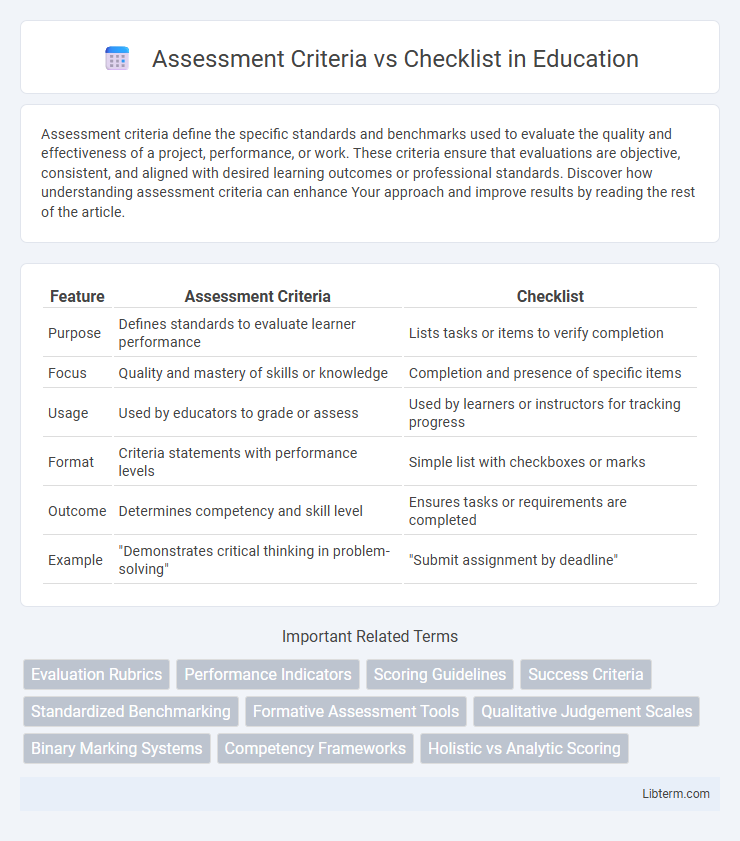Assessment criteria define the specific standards and benchmarks used to evaluate the quality and effectiveness of a project, performance, or work. These criteria ensure that evaluations are objective, consistent, and aligned with desired learning outcomes or professional standards. Discover how understanding assessment criteria can enhance Your approach and improve results by reading the rest of the article.
Table of Comparison
| Feature | Assessment Criteria | Checklist |
|---|---|---|
| Purpose | Defines standards to evaluate learner performance | Lists tasks or items to verify completion |
| Focus | Quality and mastery of skills or knowledge | Completion and presence of specific items |
| Usage | Used by educators to grade or assess | Used by learners or instructors for tracking progress |
| Format | Criteria statements with performance levels | Simple list with checkboxes or marks |
| Outcome | Determines competency and skill level | Ensures tasks or requirements are completed |
| Example | "Demonstrates critical thinking in problem-solving" | "Submit assignment by deadline" |
Understanding Assessment Criteria
Understanding assessment criteria involves recognizing specific standards that define the quality and scope of expected performance or outcomes. These criteria provide clear, measurable indicators that guide evaluation beyond simple task completion, contrasting with checklists that primarily ensure all required steps or items are accounted for. Emphasizing assessment criteria enables more nuanced judgments about proficiency, comprehension, and skill mastery in educational or professional settings.
What Is a Checklist?
A checklist is a structured tool used to itemize tasks, requirements, or components to ensure all necessary steps are completed or verified. It provides a straightforward way to track progress and maintain consistency across processes by offering a simple yes/no or done/not done format. Unlike assessment criteria that evaluate quality or performance standards, checklists focus on procedural completion and coverage.
Key Differences Between Assessment Criteria and Checklists
Assessment criteria define specific standards and measurable outcomes used to evaluate performance or quality, emphasizing the level of achievement or proficiency. Checklists serve as simple tools to ensure that all required steps, tasks, or components are completed, focusing on task completion rather than qualitative judgment. The key difference lies in assessment criteria providing qualitative evaluation metrics, while checklists offer a binary approach to tracking the presence or absence of items.
Purpose and Application in Evaluation
Assessment criteria define specific standards or benchmarks used to measure the quality or performance of a subject, focusing on qualitative and quantitative evaluation. Checklists provide a structured list of tasks or items to verify completion or presence, emphasizing thoroughness and consistency in process execution. Both tools are essential in evaluation, with assessment criteria guiding judgment and checklists ensuring systematic review.
Advantages of Using Assessment Criteria
Assessment criteria provide clear, measurable standards that enhance objectivity and consistency in evaluations across diverse contexts. They enable detailed feedback by specifying the expected performance levels, which supports targeted improvement and skill development. Using assessment criteria also facilitates fairer comparisons between individuals or projects by aligning outcomes with predefined, transparent benchmarks.
Benefits of Checklists in Assessment
Checklists in assessment provide a clear, structured framework that enhances consistency and objectivity by ensuring all required criteria are consistently addressed during evaluation. They enable quick identification of completed and pending tasks, improving efficiency and reducing the likelihood of oversight or error. By standardizing assessment steps, checklists facilitate better communication among evaluators and promote transparency in the scoring process.
When to Use Criteria vs Checklist
Assessment criteria are best used when evaluating complex skills or competencies that require detailed judgment and qualitative analysis, such as performance reviews or project evaluations. Checklists are ideal for tasks needing straightforward, objective verification of specific items or steps, like equipment inspections or routine compliance checks. Using criteria ensures nuanced assessment in subjective contexts, while checklists provide clarity and consistency in procedural or binary tasks.
Common Mistakes in Assessment Methods
Common mistakes in assessment methods include confusing assessment criteria with checklists, leading to ineffective evaluations. Assessment criteria define the standards for performance quality, while checklists simply track completion of tasks without measuring the depth of understanding or skill. Over-reliance on checklists can result in overlooking critical qualitative aspects of assessment, reducing the accuracy and fairness of the overall evaluation process.
Best Practices for Effective Evaluation
Assessment criteria provide clear, measurable standards that define the expected performance or outcomes, enabling objective and consistent evaluation. Checklists serve as practical tools for tracking task completion and ensuring all components of an assessment are addressed without omission. Combining detailed assessment criteria with comprehensive checklists supports best practices by enhancing accuracy, reliability, and efficiency in evaluation processes.
Choosing the Right Tool for Assessment
Assessment criteria define specific standards and measurable outcomes to evaluate performance or quality, while checklists serve as practical tools to ensure all necessary steps or components are addressed during an assessment. Choosing the right tool depends on the goal: assessment criteria are ideal for qualitative evaluation and detailed judgment, whereas checklists excel in verifying completeness and consistency. For comprehensive evaluation, combining both can enhance accuracy and efficiency in identifying strengths and weaknesses.
Assessment Criteria Infographic

 libterm.com
libterm.com